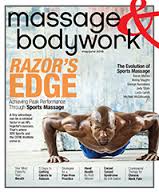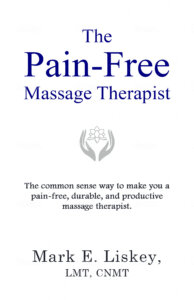The stabbing pain in my upper-back seemed to be connected to the electrical feeling in my elbow and the constant tingling in my hands. The orthopedist diagnosed me with cervical radiculopathy, cubital tunnel syndrome and unstable left shoulder. Before I could tell him about my achy fingers, he said: If I were you, I’d find a new job.
It was practical advice, what I would expect a doctor to say, but here’s the thing: I had worked through aches and pains in the massage room before, why couldn’t I do it now? Granted, these were bigger issues than before, but what if I ran an “experiment” in my massage room where everything was on the table (no pun intended)? In other words, I wouldn’t assume what I knew about body mechanics was correct. Anything goes; winner takes all.
I went with the experiment. I gave myself a year to figure out how to massage without being in pain, and at the end of the day, I was able to do massage without hurting myself or triggering old problems.
I usually tell this story before I teach my body mechanic classes to help participants understand my rationale behind my class. I’m telling you this story because if you have or are massaging in pain, there’s a reason why: You’ve been set up.
Massage is Physical
Here are two facts about massage: It’s a physical job that stresses joints, and your income as a massage therapist is dependent on how many massages your body can handle in a day. That’s a recipe for pain and injury.
With a job so “body” dependent, it’s still alarming to me when massage therapists, after reading my book, The Pain-Free Massage Therapist, ask me, “Why didn’t they teach me how take care of my body in school?”
It’s a question I have asked massage teachers. Here are the answers I get: I would like to teach more body mechanics but I have to cover so much material I don’t have time to cover it thoroughly and I have to teach for passing the licensing exam.
These answers make sense to me, and I want to be clear: I’m not saying it’s your massage teacher’s fault that you hurt. The teachers I know work their butts off trying turn out massage therapists who are knowledgeable, competent and ready to work out of the gate. They are kind and caring and do everything they can to support their massage students.
The Massage System
The problem is with the massage system which includes massage schools, licensing boards, regulatory agencies, professional groups, massage businesses, massage product suppliers, massage CE providers and media outlets.
The system is based on business relationships and financial transactions between all the parties mentioned above. Because of the financial interconnectivity, ultimately, the system doesn’t “care” how long you do massage or if you are in pain when doing massage. Don’t take it personally. It’s business.
Massage schools don’t fill seats by saying massage is tough on your body and you better know what you are doing or you will be injured or in pain and quitting massage if you don’t. Regulatory agencies are created for the health of the profession, not your health. Professional groups straddle the line between looking out for the massage therapist and keeping massage employers, massage schools, sponsors, donors and advertisers happy. Media outlets publish what is popular and are beholden to advertisers and/or parent companies that may have a business agenda where massage is a minor part.
Look Out For Yourself
The bottom line is you have to look at for you in the massage room until the system changes. Here’s what you do to look out for you in the massage room:
- Trust yourself. You know when a technique is hurting you. Stop doing it and find a replacement that doesn’t hurt your body. Easier said than done sometimes, especially when you think it is helping a client get out of pain. My guess is if you stop doing the technique that is hurting you and start substituting techniques that don’t hurt your body, you’ll find one that both works for you body and helps to reduce your client’s pain.
- Experiment. If you want to look out for your body in the massage room, you need to think about your body during the massage. I’m not saying to prioritize your body over the quality of the massage—the two, a good massage and a safe massage for your body—are not mutually exclusive. I’m saying be aware of massage techniques and body mechanic strategies that are causing you pain. Once you are aware, you can experiment with making adjustments.
Here’s what you do to change the system:
- Buy courses and study modalities with the massage-therapist’s body in mind.
You have already graduated from massage school, and learning “the best body mechanics for your body” did not happen. Massage schools are not motivated to put our bodies first until market forces push them to do so.
That said, we can start this process by demanding that modalities and CE courses are designed with massage therapists’ bodies in mind. Don’t think: I am paying a course provider to teach me a new technique. Think: I am paying a course provider to teach me a new technique and to NOT hurt my body. The provider should have or be able to create workarounds for any of their techniques that may cause you pain because of your body type, massage style or a pre-existing pain condition. Period.
Change From the Top Down
Ultimately, the massage world is selling us what we are willing to accept. Right now, we accept the next shiny massage-technique because it will make us more money or help our clients feel better no matter the toll it takes on our bodies. But the reality is you don’t make more money and help more clients by doing less massage because your body hurts from doing techniques that weren’t designed with your body in mind. So, buy classes that are “body friendly”. To protect your body in the massage room now, trust yourself to know when a technique causes you pain. Then experiment to figure out workarounds or to find substitutes. Always, I’m here if you need help.





